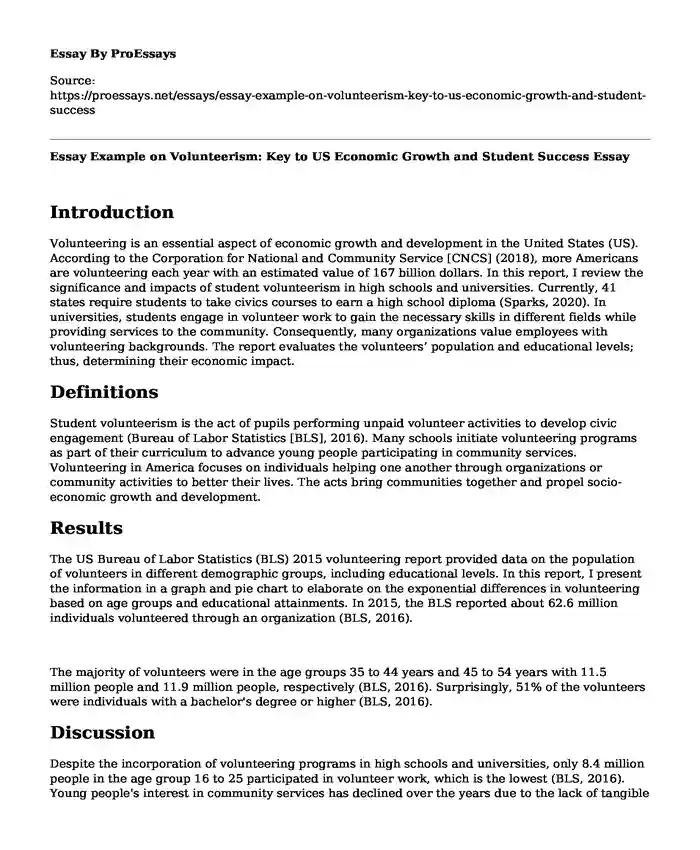Introduction
Volunteering is an essential aspect of economic growth and development in the United States (US). According to the Corporation for National and Community Service [CNCS] (2018), more Americans are volunteering each year with an estimated value of 167 billion dollars. In this report, I review the significance and impacts of student volunteerism in high schools and universities. Currently, 41 states require students to take civics courses to earn a high school diploma (Sparks, 2020). In universities, students engage in volunteer work to gain the necessary skills in different fields while providing services to the community. Consequently, many organizations value employees with volunteering backgrounds. The report evaluates the volunteers’ population and educational levels; thus, determining their economic impact.
Definitions
Student volunteerism is the act of pupils performing unpaid volunteer activities to develop civic engagement (Bureau of Labor Statistics [BLS], 2016). Many schools initiate volunteering programs as part of their curriculum to advance young people participating in community services. Volunteering in America focuses on individuals helping one another through organizations or community activities to better their lives. The acts bring communities together and propel socio-economic growth and development.
Results
The US Bureau of Labor Statistics (BLS) 2015 volunteering report provided data on the population of volunteers in different demographic groups, including educational levels. In this report, I present the information in a graph and pie chart to elaborate on the exponential differences in volunteering based on age groups and educational attainments. In 2015, the BLS reported about 62.6 million individuals volunteered through an organization (BLS, 2016).
The majority of volunteers were in the age groups 35 to 44 years and 45 to 54 years with 11.5 million people and 11.9 million people, respectively (BLS, 2016). Surprisingly, 51% of the volunteers were individuals with a bachelor's degree or higher (BLS, 2016).
Discussion
Despite the incorporation of volunteering programs in high schools and universities, only 8.4 million people in the age group 16 to 25 participated in volunteer work, which is the lowest (BLS, 2016). Young people's interest in community services has declined over the years due to the lack of tangible rewards. Most students are goal-oriented and are always motivated by the availability of awards after accomplishing a task. Furthermore, the volunteer programs in civics courses do not involve service-learning projects (Sparks, 2020). Therefore, students do not feel obliged to develop civic engagement unless it is about a matter that significantly impacts their life, such as the campaign against school shootings.
Nonetheless, the number of volunteers increased as the age groups' years increased. The age groups 35 to 44 years and 45 to 54 years recorded the highest number of volunteers (BLS, 2016). Career accomplishments account for the rise as individuals are better positioned to give back to the community through fundraising or unpaid services during their free time. Moreover, 51% of volunteers had a bachelor's degree or higher educational achievement (BLS, 2016). The educational background established civic engagement; thus, making it easier to participate in community services.
Student volunteerism is the backbone of volunteering in America, which is a multi-billion economic sector. With an estimated 167 billion dollars, the volunteers' contributions are integral to the socio-economic development of many US communities (CNCS, 2018). Many organizations tend to employ workers with volunteering history to ensure the provision of services that better the society rather than their own goals. Moreover, high school and university students gain the necessary life skills and learn the importance of civic engagement. The culture gives them an understanding of the power of service and fighting together to better the lives of others.
Conclusion
Volunteering is a critical component of community development. As the most of the volunteers are university graduates, it is significant to incorporate the student volunteerism culture at an early age to encourage young people to participate in community services. Civic engagement enables individuals to understand the necessity of helping each other for the greater good of society. Furthermore, students are the future of every nation, and volunteerism helps them support the common goal of developing an inclusive society.
References
Bureau of Labor Statistics (BLS), US Department of Labor. (2016). Volunteering in the United States, 2015. https://www.bls.gov/news.release/pdf/volun.pdf
Corporation for National and Community Service (CNCS). (2018). Volunteering in the US hits record high; Worth $167 billion. https://www.nationalservice.gov/newsroom/press-releases/2018/volunteering-us-hits-record-high-worth-167-billion
Sparks, S. D. (2020, April 29). Volunteerism declined among young people. Education Week. https://www.edweek.org/ew/articles/2018/07/18/volunteerism-declined-among-young-people.html.
Cite this page
Essay Example on Volunteerism: Key to US Economic Growth and Student Success. (2023, Oct 22). Retrieved from https://proessays.net/essays/essay-example-on-volunteerism-key-to-us-economic-growth-and-student-success
If you are the original author of this essay and no longer wish to have it published on the ProEssays website, please click below to request its removal:
- Immigration Story
- Social Construction of Power: Research Proposal
- Cuba to America: Joel Ruiz's Racial Awakening - Essay Sample
- Essay Example on Unite Mindfulness & SEL for More Impactful Learning
- Witnessing the American Civil Rights Movement: A Journey of Liberation & Equality - Essay Sample
- Essay Example on Unlock Collective Power: Civil Engagement and Interests Groups
- Essay Example on Harvard HMX: A Critical Course for Medical Aspirants







